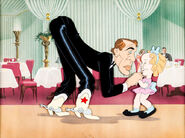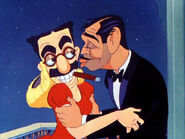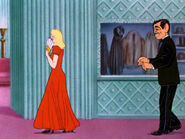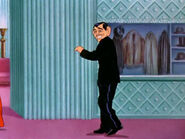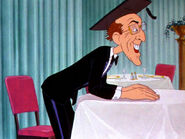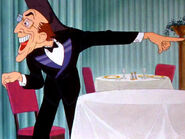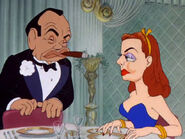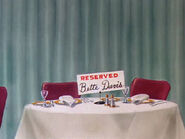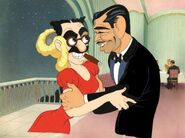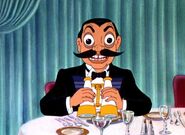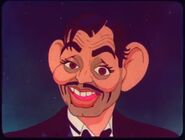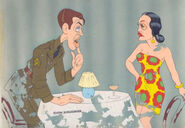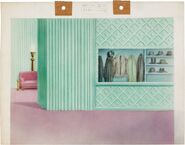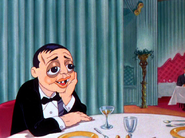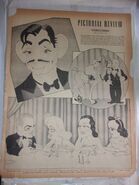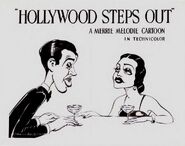PopKorn Kat (talk | contribs) mNo edit summary |
No edit summary Tag: Visual edit |
||
| (35 intermediate revisions by 11 users not shown) | |||
| Line 1: | Line 1: | ||
| + | {{Infobox Shorts wTabs |
||
| − | {{Infobox_Shorts |
||
|name = Hollywood Steps Out |
|name = Hollywood Steps Out |
||
| − | |image = |
+ | |image = <tabber> |
| + | |-|Original = [[File:IMG_2328.png|thumb|center|280px]] |
||
| + | |-|Reissue = [[File:Hollywood Steps Out.png|thumb|center|280px]] |
||
| + | </tabber> |
||
|Director = [[Tex Avery|Fred Avery]] |
|Director = [[Tex Avery|Fred Avery]] |
||
|producer = [[Leon Schlesinger]] |
|producer = [[Leon Schlesinger]] |
||
|airdate = May 24, 1941 |
|airdate = May 24, 1941 |
||
|series = [[Merrie Melodies]] |
|series = [[Merrie Melodies]] |
||
| − | |Voice = [[Mel Blanc]]<br>[[Sara Berner]]<br>[[Kent Rogers]] |
+ | |Voice = [[Mel Blanc]] (uncredited) <br>[[Sara Berner]] (uncredited) <br>[[Kent Rogers]] (uncredited) |
| − | |Starring = Cary Grant<br>Clark Gable<br>James Cagney<br>Bing Crosby<br>Lewis Stone<br>Ned Sparks<br>Groucho Marx<br>Greta Garbo<br>Coat Check Girl<br>Henry Fonda's Mother<br>Dorothy Lamour<br>Jerry Colonna<br>Peter Lorre<br>Jimmy Stewart<br>Mickey Rooney<br>Henry Fonda |
+ | |Starring = Cary Grant <br>Clark Gable <br>James Cagney <br>Bing Crosby <br>Lewis Stone <br>Ned Sparks <br>Groucho Marx <br>Greta Garbo <br>Coat Check Girl <br>Henry Fonda's Mother <br>Dorothy Lamour <br>Jerry Colonna <br>Peter Lorre <br>Jimmy Stewart <br>Mickey Rooney <br>Henry Fonda |
|previous = [[Farm Frolics]] |
|previous = [[Farm Frolics]] |
||
|next = [[A Coy Decoy]] |
|next = [[A Coy Decoy]] |
||
| − | |video = [[File:LOONEY TUNES (Looney Toons)- Hollywood Steps Out (1941) -ULTRA HD 4K Remastered- |
+ | |video = [[File:LOONEY TUNES (Looney Toons)- Hollywood Steps Out (1941) -ULTRA HD 4K Remastered-|thumb|center|280px]] |
| + | [[File:1941-05-24 Hollywood Steps Out (MM)-0|thumb|center|280px]] |
||
|Writer = [[Melvin Millar]] |
|Writer = [[Melvin Millar]] |
||
| − | |Animators = [[Rod Scribner]]<br>[[Robert McKimson|Bob McKimson]] (uncredited)<br>[[Virgil Ross]] (uncredited) |
+ | |Animators = [[Rod Scribner]] <br>[[Robert McKimson|Bob McKimson]] (uncredited) <br>[[Virgil Ross]] (uncredited) <br>[[Ben Shenkman]] (character designer) (uncredited) |
|Layout-artist = |
|Layout-artist = |
||
| + | |Background-artist =[[John Didrik Johnsen]] (uncredited)<ref>https://tralfaz.blogspot.com/2020/05/she-has-oomph.html</ref> |
||
| − | |Background-artist = |
||
| − | |Sound effects = [[Treg Brown]] |
+ | |Sound effects = [[Treg Brown]] (uncredited) |
| − | |Musician = [[Carl W. Stalling]] |
+ | |Musician = [[Carl W. Stalling]] |
| + | }} |
||
| − | '''Hollywood Steps Out |
+ | '''Hollywood Steps Out''' is a [[1941]] ''[[Merrie Melodies]]'' short directed by [[Tex Avery|Fred Avery]]. |
| − | ==Plot== |
+ | == Plot == |
| − | A large bird's-eye view of a city is shown with beams of light moving to a conga beat. The action takes place in the famed Ciro's nightclub, where the Hollywood stars are having dinner |
+ | A large bird's-eye view of a city is shown with beams of light moving to a conga beat. The action takes place in the famed Ciro's nightclub, where the Hollywood stars are having dinner at $50 a plate and "easy terms", including Claudette Colbert, Don Ameche and Cary Grant. Grant talks to himself: “What a place! What a place! It’s as pretty as a picture. But if I ever told my favorite wife the awful truth I'd land right on the front page. Yessireee Bobby.” |
| − | Then Greta Garbo comes along selling cigars, cigarettes, and butts. Grant buys some and asks her for a light. Garbo lifts her enormous foot on the table and strikes a match to it, then lights |
+ | Then Greta Garbo comes along selling cigars, cigarettes, and butts. Grant buys some and asks her for a light. Garbo lifts her enormous foot on the table and strikes a match to it, then lights Grant's cigarette. |
| − | + | Edward G. Robinson asks Ann Sheridan: “How’s the Oomph girl tonight?” Sheridan responds by uttering the word “Oomph” several times. Her final “Oomph” surprises Robinson. (Sheridan was a sex symbol known as the “Oomph” girl in those years.) |
|
| − | + | One table has [[Henry Binder]] and [[Leon Schlesinger]] sitting there as an inside joke, while the soundtrack quotes "[[Merrily We Roll Along]]". Another table is reserved for Bette Davis, a large sofa for Kate Smith, noted for her obesity, and a table for comic (and movie and radio) characters Blondie, Dagwood, and Baby Dumpling, with a fire hydrant for Daisy the dog. |
|
Meanwhile, in the cloakroom Johnny Weissmuller has arrived. He leaves his tuxedo behind to reveal his Tarzan outfit. Sally Rand (famous for her striptease acts and fan dance), leaves her feathers behind and leaves presumably naked. |
Meanwhile, in the cloakroom Johnny Weissmuller has arrived. He leaves his tuxedo behind to reveal his Tarzan outfit. Sally Rand (famous for her striptease acts and fan dance), leaves her feathers behind and leaves presumably naked. |
||
| − | + | James Cagney informs Humphrey Bogart and George Raft that they got to prepare to do something risky. The trio, all known for their "tough guy" roles, get ready, run off, and then turn out to be pitching pennies. Harpo Marx, usually the prankster in The Marx Brothers films, sticks some matches under Garbo's foot, then lights it. Garbo reacts very slowly and coolly to the pain in reference to her serene and cool acting style by slowly saying, "Ouuchhh." Then Clark Gable spots a girl, whom he follows with his head turning around 180 degrees. |
|
| − | After this, Bing Crosby announces the first act that evening. During his speech he is interrupted by a jockey on a race horse (a reference to |
+ | After this, Bing Crosby announces the first act that evening. During his speech he is interrupted by a jockey on a race horse (a reference to Crosby's fondness for horse race betting and his lack of luck in these games). Crosby then introduces the first musical number by conductor Leopold Stokowski. Stokowski, who has a hair net containing his long hair, prepares himself dramatically and seriously to conducting what looks to be some classical orchestral arrangement. However, it's a conga beat to which he moves rhythmically. |
| − | The beat |
+ | The beat "does something" to Dorothy Lamour, who is sitting at a table with James Stewart. She begs him to go dancing with her. Stewart starts stuttering and hesitating, but agrees to follow her to the dance floor. (Stewart was known for his “shy guy” type roles). When she moves her body to the beat he gets scared and runs away, leaving a sign reading Mr. Smith Goes To Washington. |
| − | + | Gable is still moving to the beat and at the same time following the girl he saw earlier. |
|
| − | Tyrone Power dances with Sonja Henie |
+ | Tyrone Power dances with Sonja Henie, who's still wearing her ice skates. Frankenstein's monster is dancing very stiffly and woodenly. The Three Stooges poke and smash each other in beat to the rhythm. Oliver Hardy dances with someone as well and is shown from the back. When he turns his face to the camera he is revealed to be dancing with two girls at the same time. Cesar Romero, known for his roles as a Latin lover, dances with Rita Hayworth. Romero's extremely large feet rip fabric from Hayworth's dress by friction. |
| − | + | Mickey Rooney and Judy Garland sit at a table. The waiter brings an expensive bill, which shocks Rooney. He asks his "father", Lewis Stone, for a favor. Both then wash the dishes to the conga beat. |
|
| − | Gable is |
+ | Gable is still following the girl. Then Crosby introduces the final act, again interrupted by the same jockey on his race horse. Sally Rand performs the bubble dance, a famous scene from her film Bolero, in complete nudity, which is never seen although parts of her body get revealed. |
| − | Kay Kyser |
+ | Kay Kyser, nicknamed "The Professor", is excited by the act and shouts out, "Students!" A group of people look, whistle in unison and exclaim: "Baby!" They are William Powell, Spencer Tracy, Douglas Fairbanks and Errol Flynn. Sitting down are Wallace Beery and Aubrey Smith. Peter Lorre, known for his portrayal of sinister and weird characters, says dreamily: "I haven't seen such a beautiful bubble since I was a child." Henry Fonda enjoys the act too, but is pulled away by his mother. (This is a reference to the popular radio show The Aldrich Family which always opened with the cry: "Hen-ryyyyyyyy! Henry Aldrich!" by the mother of the teenage title character, Henry Aldrich) J. Edgar Hoover says "Gee!" several times as a pun to his function as G-man. Boris Karloff, Arthur Treacher, Buster Keaton and Mischa Auer watch the spectacle without any emotion. Ned Sparks asks them if they are having a good time. They all react dryly, "Yes!" Jerry Colonna reacts in excitement to the act and utters his catchphrases "Guess who?", and the camera reveals an invisible character next to him: "Jehudi!" ("Who's Jehudi" was a catch phrase Colonna was famous for.) |
| − | Finally Harpo Marx shoots the bubble with a slingshot. The bubble explodes and Sally Rand is shown wearing a barrel underneath. The conga stops and |
+ | Finally Harpo Marx shoots the bubble with a slingshot. The bubble explodes and Sally Rand is shown wearing a barrel underneath. The conga stops and Gable who has finally caught the girl he was chasing. "She" turns out to be Groucho Marx in drag. |
| − | ==Availability== |
+ | == Availability == |
| − | * |
+ | * LaserDisc - ''[[The Golden Age of Looney Tunes]]'', Vol. 1, Side 9: Hooray for Hollywood |
| − | *VHS - ''The Golden Age of Looney Tunes'', Vol. 9: Hooray for Hollywood |
+ | * VHS - ''The Golden Age of Looney Tunes'', Vol. 9: Hooray for Hollywood |
| − | * |
+ | * VHS - ''[[Looney Tunes: The Collectors Edition]]'' Volume 8: Tex-Book Looney (1995 Turner dubbed version) |
| − | * |
+ | * DVD - ''[[Looney Tunes Golden Collection: Volume 2]]'', Disc 4 |
| + | * Blu-ray, DVD - ''[[Looney Tunes Platinum Collection: Volume 2]]'', Disc 2 (same print as LTGCV2) (with optional audio commentary by Greg Ford) |
||
| − | |||
| + | * DVD - ''[[Looney Tunes: Parodies Collection]]''(same print as LTGCV2) |
||
| ⚫ | |||
| ⚫ | * When this short aired on the former WB network, two parts concerning cigarettes and playing with matches were cut: one where Greta Garbo (working as a cigarette girl) uses her large shoe to light Cary Grant's cigarette, and another, where Harpo Marx sticks matches in Garbo's shoes and lights them (the "hot foot" gag seen in many classic theatrical cartoon shorts), with Garbo slowly reacting to the pain. |
||
| ⚫ | |||
| ⚫ | * When this short aired on the former WB network, two parts concerning cigarettes and playing with matches were cut: one where Greta Garbo (working as a cigarette girl) uses her large shoe to light Cary Grant's cigarette, and another, where Harpo Marx sticks matches in Garbo's shoes and lights them (the "hot foot" gag seen in many classic theatrical cartoon shorts), with Garbo slowly reacting to the pain.<ref>http://www.intanibase.com/gac/looneytunes/censored-h.aspx</ref> |
||
* Two scenes were cut from the 1948 Blue Ribbon reissue (which is the version that airs on television and is included in official and unofficial home video releases): |
* Two scenes were cut from the 1948 Blue Ribbon reissue (which is the version that airs on television and is included in official and unofficial home video releases): |
||
** The first was Gary Cooper (who is insanely tall) and Shirley Temple (who is insanely short) dancing during the conga sequence. |
** The first was Gary Cooper (who is insanely tall) and Shirley Temple (who is insanely short) dancing during the conga sequence. |
||
| − | ** The second was the original ending. According to |
+ | ** The second was the original ending. According to Bob Clampett's widow, Sody, Bob told several historians that after Groucho said "Well, fancy meeting you here!" (which is where the cartoon ends on most current versions in circulation), Clark Gable said something along the lines of "Awwwww well, I still want what's comin' to me, and I'm a-gonna get it!" before kissing Groucho Marx anyway. Sody recalled that Clark Gable himself demanded the joke be removed because he was worried that it would hurt his reputation and career.<ref>http://baxterfilms.tumblr.com/post/113067022354/hollywood-steps-out-is-often-seen-in-its-1949</ref> |
| − | ==Notes== |
+ | == Notes == |
| + | * The short subject features caricatures of popular Hollywood stars from the 1930s and 1940s. |
||
| ⚫ | |||
| + | * All Grant's jokes are references to some of his films, except ''The Front Page'' which does not star Grant, but was remade as ''His Girl Friday'' in 1941, a film that does star him. |
||
| + | * Jokes about Crosby's horse racing betting passion would be referenced in other ''Looney Tunes'' cartoons as well, such as "[[The Old Grey Hare]]". |
||
| + | * Mickey Rooney played the small town boy who always got into trouble with money and girls in the ''Andy Hardy'' film series; Lewis Stone played Andy's father, Judge Hardy; Judy played his girl, Friday. |
||
| + | * All of the male celebrities except for Jerry Colonna, who was voiced by Mel Blanc, were voiced by Kent Rogers. |
||
| + | * This short fell into the public domain when [[United Artists]] (successor to [[Associated Artists Productions]]) failed to renew the copyright in time. |
||
| ⚫ | |||
| + | * Scenes that featured actresses Bette Davis and Katharine Hepburn were cut before the release of this short even though there was a scene that featured a table reserved for Bette Davis. |
||
| − | ==Gallery== |
+ | == Gallery == |
<gallery> |
<gallery> |
||
| − | Tumblr inline nkvmqtJ5Yt1qi11a7.jpg|Original production cel of Gary Cooper and Shirley Temple, that was omitted from the 1948 reissue, probably due to the irrelevance of the gag. |
+ | Tumblr inline nkvmqtJ5Yt1qi11a7.jpg|Original production cel of Gary Cooper and Shirley Temple, that was omitted from the 1948 reissue, probably due to the irrelevance of the gag. |
| + | bandicam 2019-09-02 21-25-38-053.jpg|"Well, fancy meeting you here!" |
||
| + | bandicam 2019-09-02 21-26-34-799.jpg |
||
| + | bandicam 2019-09-02 21-26-36-708.jpg|"Don't go away folks! This 'ought to be good!" |
||
| + | bandicam 2019-09-02 21-27-04-109.jpg |
||
| + | bandicam 2019-09-02 21-27-06-261.jpg|"Students!" |
||
| + | bandicam 2019-09-02 21-28-36-272.jpg|"How's the oomph girl tonight?" |
||
| + | bandicam 2019-09-02 21-28-48-159.jpg|[[Henry Binder]] and [[Leon Schlesinger]] |
||
| + | bandicam 2019-09-02 21-26-45-682.jpg|"Keep moving, boys. l'll see you at the track." |
||
| + | bandicam 2019-09-02 21-29-44-644.jpg |
||
| + | ee58b3050685e30497830b037441a8e9.jpg |
||
| + | MV5BZTUzOWQ1MjktZTcwYy00ZmI5LTliNzYtMTU1ZDU5NWIzZGZjXkEyXkFqcGdeQXVyMzkyOTg1MzE@._V1_.jpg|"Guess who?" |
||
| + | MV5BNmY1ZWQ4MjktMDYwYS00MWM4LTllMWUtNWEyMTc5YjYwNGVhXkEyXkFqcGdeQXVyNDgyODgxNjE@._V1_.jpg|"Yehudi!" |
||
| + | MV5BNWU4MmUzYmYtNDgzNi00OTI1LTk2ZmYtYTJmYTZjNTFmMjBhXkEyXkFqcGdeQXVyMTU5NjQzMzU@._V1_.jpg|"I'm a bad boy!" |
||
| + | Hollywoodso1.jpg |
||
| + | Hollywood_steps_out_(33).png|"You boys having a good time?" |
||
| + | Background Hollywood steps out.jpg |
||
| + | Screen Shot 2014-04-23 at 00.05.07.png|"I haven't seen such a beautiful bubble, since I was a child." |
||
| + | caricatures clark peter edward.jpg |
||
| + | 7fa0f339aded9cb374e34f14b58035b6.jpg|A trade ad which features Bette Davis |
||
| + | lobby card hollywood steps out.jpg|Lobby card |
||
</gallery> |
</gallery> |
||
| + | |||
| − | ==References== |
+ | == References == |
<references /> |
<references /> |
||
| + | |||
| + | |||
| + | {{-}} |
||
[[Category:Shorts]] |
[[Category:Shorts]] |
||
[[Category:1941]] |
[[Category:1941]] |
||
| Line 76: | Line 113: | ||
[[Category:Blue Ribbon reissues]] |
[[Category:Blue Ribbon reissues]] |
||
[[Category:Caricatures of real people]] |
[[Category:Caricatures of real people]] |
||
| ⚫ | |||
[[Category:Hollywood in Cartoons]] |
[[Category:Hollywood in Cartoons]] |
||
| − | [[Category:Cartoons written by Melvin Millar]] |
||
| − | [[Category:Cartoons animated by Rod Scribner]] |
||
| − | [[Category:Cartoons animated by Robert McKimson]] |
||
| − | [[Category:Cartoons animated by Virgil Ross]] |
||
[[Category:Cartoons with music by Carl W. Stalling]] |
[[Category:Cartoons with music by Carl W. Stalling]] |
||
[[Category:Cartoons with film editing by Treg Brown]] |
[[Category:Cartoons with film editing by Treg Brown]] |
||
| Line 87: | Line 119: | ||
[[Category:Cartoons with orchestrations by Milt Franklyn]] |
[[Category:Cartoons with orchestrations by Milt Franklyn]] |
||
[[Category:Cartoons with characters voiced by Mel Blanc]] |
[[Category:Cartoons with characters voiced by Mel Blanc]] |
||
| − | [[Category:Cartoons with characters voiced by Sara Berner]] |
||
[[Category:Cartoons with characters voiced by Kent Rogers]] |
[[Category:Cartoons with characters voiced by Kent Rogers]] |
||
[[Category:Cartoons with characters voiced by Dave Barry]] |
[[Category:Cartoons with characters voiced by Dave Barry]] |
||
| Line 94: | Line 125: | ||
[[Category:One-Shot Cartoons]] |
[[Category:One-Shot Cartoons]] |
||
[[Category:Public domain films]] |
[[Category:Public domain films]] |
||
| ⚫ | |||
| + | [[Category:Re-released cartoons whose original titles are known to exist]] |
||
Revision as of 23:02, 18 May 2020
Template:Infobox Shorts wTabs Hollywood Steps Out is a 1941 Merrie Melodies short directed by Fred Avery.
Plot
A large bird's-eye view of a city is shown with beams of light moving to a conga beat. The action takes place in the famed Ciro's nightclub, where the Hollywood stars are having dinner at $50 a plate and "easy terms", including Claudette Colbert, Don Ameche and Cary Grant. Grant talks to himself: “What a place! What a place! It’s as pretty as a picture. But if I ever told my favorite wife the awful truth I'd land right on the front page. Yessireee Bobby.”
Then Greta Garbo comes along selling cigars, cigarettes, and butts. Grant buys some and asks her for a light. Garbo lifts her enormous foot on the table and strikes a match to it, then lights Grant's cigarette.
Edward G. Robinson asks Ann Sheridan: “How’s the Oomph girl tonight?” Sheridan responds by uttering the word “Oomph” several times. Her final “Oomph” surprises Robinson. (Sheridan was a sex symbol known as the “Oomph” girl in those years.)
One table has Henry Binder and Leon Schlesinger sitting there as an inside joke, while the soundtrack quotes "Merrily We Roll Along". Another table is reserved for Bette Davis, a large sofa for Kate Smith, noted for her obesity, and a table for comic (and movie and radio) characters Blondie, Dagwood, and Baby Dumpling, with a fire hydrant for Daisy the dog.
Meanwhile, in the cloakroom Johnny Weissmuller has arrived. He leaves his tuxedo behind to reveal his Tarzan outfit. Sally Rand (famous for her striptease acts and fan dance), leaves her feathers behind and leaves presumably naked.
James Cagney informs Humphrey Bogart and George Raft that they got to prepare to do something risky. The trio, all known for their "tough guy" roles, get ready, run off, and then turn out to be pitching pennies. Harpo Marx, usually the prankster in The Marx Brothers films, sticks some matches under Garbo's foot, then lights it. Garbo reacts very slowly and coolly to the pain in reference to her serene and cool acting style by slowly saying, "Ouuchhh." Then Clark Gable spots a girl, whom he follows with his head turning around 180 degrees.
After this, Bing Crosby announces the first act that evening. During his speech he is interrupted by a jockey on a race horse (a reference to Crosby's fondness for horse race betting and his lack of luck in these games). Crosby then introduces the first musical number by conductor Leopold Stokowski. Stokowski, who has a hair net containing his long hair, prepares himself dramatically and seriously to conducting what looks to be some classical orchestral arrangement. However, it's a conga beat to which he moves rhythmically.
The beat "does something" to Dorothy Lamour, who is sitting at a table with James Stewart. She begs him to go dancing with her. Stewart starts stuttering and hesitating, but agrees to follow her to the dance floor. (Stewart was known for his “shy guy” type roles). When she moves her body to the beat he gets scared and runs away, leaving a sign reading Mr. Smith Goes To Washington.
Gable is still moving to the beat and at the same time following the girl he saw earlier.
Tyrone Power dances with Sonja Henie, who's still wearing her ice skates. Frankenstein's monster is dancing very stiffly and woodenly. The Three Stooges poke and smash each other in beat to the rhythm. Oliver Hardy dances with someone as well and is shown from the back. When he turns his face to the camera he is revealed to be dancing with two girls at the same time. Cesar Romero, known for his roles as a Latin lover, dances with Rita Hayworth. Romero's extremely large feet rip fabric from Hayworth's dress by friction.
Mickey Rooney and Judy Garland sit at a table. The waiter brings an expensive bill, which shocks Rooney. He asks his "father", Lewis Stone, for a favor. Both then wash the dishes to the conga beat.
Gable is still following the girl. Then Crosby introduces the final act, again interrupted by the same jockey on his race horse. Sally Rand performs the bubble dance, a famous scene from her film Bolero, in complete nudity, which is never seen although parts of her body get revealed.
Kay Kyser, nicknamed "The Professor", is excited by the act and shouts out, "Students!" A group of people look, whistle in unison and exclaim: "Baby!" They are William Powell, Spencer Tracy, Douglas Fairbanks and Errol Flynn. Sitting down are Wallace Beery and Aubrey Smith. Peter Lorre, known for his portrayal of sinister and weird characters, says dreamily: "I haven't seen such a beautiful bubble since I was a child." Henry Fonda enjoys the act too, but is pulled away by his mother. (This is a reference to the popular radio show The Aldrich Family which always opened with the cry: "Hen-ryyyyyyyy! Henry Aldrich!" by the mother of the teenage title character, Henry Aldrich) J. Edgar Hoover says "Gee!" several times as a pun to his function as G-man. Boris Karloff, Arthur Treacher, Buster Keaton and Mischa Auer watch the spectacle without any emotion. Ned Sparks asks them if they are having a good time. They all react dryly, "Yes!" Jerry Colonna reacts in excitement to the act and utters his catchphrases "Guess who?", and the camera reveals an invisible character next to him: "Jehudi!" ("Who's Jehudi" was a catch phrase Colonna was famous for.)
Finally Harpo Marx shoots the bubble with a slingshot. The bubble explodes and Sally Rand is shown wearing a barrel underneath. The conga stops and Gable who has finally caught the girl he was chasing. "She" turns out to be Groucho Marx in drag.
Availability
- LaserDisc - The Golden Age of Looney Tunes, Vol. 1, Side 9: Hooray for Hollywood
- VHS - The Golden Age of Looney Tunes, Vol. 9: Hooray for Hollywood
- VHS - Looney Tunes: The Collectors Edition Volume 8: Tex-Book Looney (1995 Turner dubbed version)
- DVD - Looney Tunes Golden Collection: Volume 2, Disc 4
- Blu-ray, DVD - Looney Tunes Platinum Collection: Volume 2, Disc 2 (same print as LTGCV2) (with optional audio commentary by Greg Ford)
- DVD - Looney Tunes: Parodies Collection(same print as LTGCV2)
Censorship
- When this short aired on the former WB network, two parts concerning cigarettes and playing with matches were cut: one where Greta Garbo (working as a cigarette girl) uses her large shoe to light Cary Grant's cigarette, and another, where Harpo Marx sticks matches in Garbo's shoes and lights them (the "hot foot" gag seen in many classic theatrical cartoon shorts), with Garbo slowly reacting to the pain.[1]
- Two scenes were cut from the 1948 Blue Ribbon reissue (which is the version that airs on television and is included in official and unofficial home video releases):
- The first was Gary Cooper (who is insanely tall) and Shirley Temple (who is insanely short) dancing during the conga sequence.
- The second was the original ending. According to Bob Clampett's widow, Sody, Bob told several historians that after Groucho said "Well, fancy meeting you here!" (which is where the cartoon ends on most current versions in circulation), Clark Gable said something along the lines of "Awwwww well, I still want what's comin' to me, and I'm a-gonna get it!" before kissing Groucho Marx anyway. Sody recalled that Clark Gable himself demanded the joke be removed because he was worried that it would hurt his reputation and career.[2]
Notes
- The short subject features caricatures of popular Hollywood stars from the 1930s and 1940s.
- All Grant's jokes are references to some of his films, except The Front Page which does not star Grant, but was remade as His Girl Friday in 1941, a film that does star him.
- Jokes about Crosby's horse racing betting passion would be referenced in other Looney Tunes cartoons as well, such as "The Old Grey Hare".
- Mickey Rooney played the small town boy who always got into trouble with money and girls in the Andy Hardy film series; Lewis Stone played Andy's father, Judge Hardy; Judy played his girl, Friday.
- All of the male celebrities except for Jerry Colonna, who was voiced by Mel Blanc, were voiced by Kent Rogers.
- This short fell into the public domain when United Artists (successor to Associated Artists Productions) failed to renew the copyright in time.
- This cartoon was reissued (re-released) on October 2, 1948, the same date that "Odor of the Day" was released.
- Scenes that featured actresses Bette Davis and Katharine Hepburn were cut before the release of this short even though there was a scene that featured a table reserved for Bette Davis.
Gallery
References

